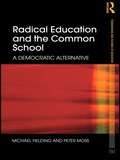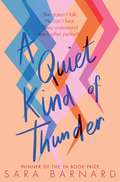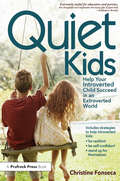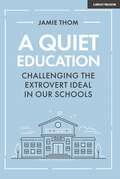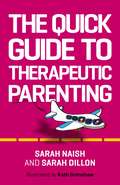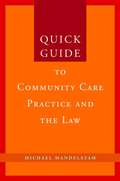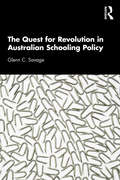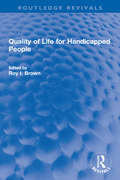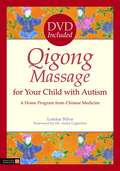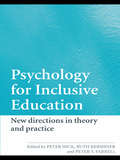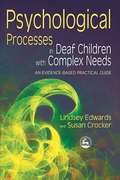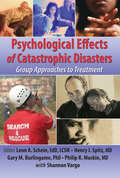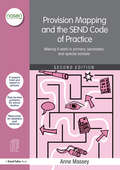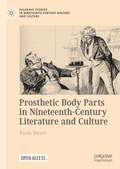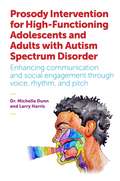- Table View
- List View
Radical Education and the Common School: A Democratic Alternative (Foundations and Futures of Education)
by Michael Fielding Peter MossWhat is education, what is it for and what are its fundamental values? How do we understand knowledge and learning? What is our image of the child and the school? How does the ever more pressing need to develop a more just, creative and sustainable democratic society affect our responses to these questions? Addressing these fundamental issues, Fielding and Moss contest the current mainstream dominated by markets and competition, instrumentality and standardisation, managerialism and technical practice. They argue instead for a radical education with democracy as a fundamental value, care as a central ethic, a person-centred education that is education in the broadest sense, and an image of a child rich in potential. Radical education, they say, should be practiced in the ‘common school’, a school for all children in its local catchment area, age-integrated, human scale, focused on depth of learning and based on team working. A school understood as a public space for all citizens, a collective workshop of many purposes and possibilities, and a person-centred learning community, working closely with other schools and with local authorities. The book concludes by examining how we might bring such transformation about. Written by two of the leading experts in the fields of early childhood and secondary education, the book covers a wide vista of education for children and young people. Vivid examples from different stages of education are used to explore the full meaning of radical democratic education and the common school and how they can work in practice. It connects rich thinking and experiences from the past and present to offer direction and hope for the future. It will be of interest and inspiration to all who care about education - teachers and students, academics and policy makers, parents and politicians.
A Quiet Kind of Thunder
by Sara BarnardSteffi doesn't talk. Rhys can't hear.They understand each other perfectly. Love isn't always a lightning strike. Sometimes it's the rumbling roll of thunder . . .From the bestselling author of Beautiful Broken Things, Sara Barnard's A Quiet Kind of Thunder is stunning love story about the times when a whisper is as good as a shout.Steffi has been a selective mute for most of her life – she's been silent for so long that she feels completely invisible. But Rhys, the new boy at school, sees her. He's deaf, and her knowledge of basic sign language means that she's assigned to look after him. To Rhys it doesn't matter that Steffi doesn't talk and, as they find ways to communicate, Steffi finds that she does have a voice, and that she's falling in love with the one person who makes her feel brave enough to use it.
Quiet Kids: Help Your Introverted Child Succeed in an Extroverted World
by Christine FonsecaBeing an introverted child is difficult, especially in an ever-increasingly noisy world. Often viewed as aloof, unmotivated, or conceited, introverted children are deeply misunderstood by parents, educators, and even their peers. That's where Quiet Kids: Help Your Introverted Child Succeed in an Extroverted World comes in. Designed to provide parents with a blueprint for understanding the nature of introversion, Quiet Kids provides specific strategies to teach children how to thrive in a world that may not understand them. Presented in an easy-to-read, conversational style, the book uses real-world examples and stories from introverts and parents to show parents and educators how to help children develop resiliency and enhance the positive qualities of being an introvert. With specific strategies to address academic performance, bullying, and resiliency, Quiet Kids is a must-read for anyone wishing to enhance the lives of introverted children.
Quiet Kids: Help Your Introverted Child Succeed in an Extroverted World
by Christine FonsecaBeing an introverted child is difficult, especially in an ever-increasingly noisy world. Often viewed as aloof, unmotivated, or conceited, introverted children are deeply misunderstood by parents, educators, and even their peers. That's where Quiet Kids: Help Your Introverted Child Succeed in an Extroverted World comes in. Designed to provide parents with a blueprint for understanding the nature of introversion, Quiet Kids provides specific strategies to teach children how to thrive in a world that may not understand them. Presented in an easy-to-read, conversational style, the book uses real-world examples and stories from introverts and parents to show parents and educators how to help children develop resiliency and enhance the positive qualities of being an introvert. With specific strategies to address academic performance, bullying, and resiliency, Quiet Kids is a must-read for anyone wishing to enhance the lives of introverted children.
A Quiet Education: Challenging the extrovert ideal in our schools
by Jamie Thom'A Quiet Education' serves as an unashamed cheerleader for all that is quiet, challenging the myth that collaboration and noise should be at the heart of what happens in schools. It examines how we can ensure more introverted students and teachers can thrive and achieve their potential. It also explores why it is essential that all teachers begin to embrace quieter values: in their classrooms and management of behaviour; in sustaining their own wellbeing; in their desire to reflect meaningfully and improve as a teacher. The final section is an exploration of quieter skills: how we can strengthen our students' metacognitive ability; their ability to listen, pay attention and focus; the quality of independent work we do in the classroom alongside how we can motivate all our students.
The Quick Guide to Therapeutic Parenting: A Visual Introduction (Therapeutic Parenting Books)
by Sarah Naish Sarah DillonTherapeutic parenting is not your usual parenting style. It's a special, specific way to raise kids who have experienced trauma in their past, and requires a lot of commitment and determination - this is about far more than love and care.But where do you start?This book is the ideal first step for anyone who wants to understand how therapeutic parenting works. It offers simple summaries of the key ideas behind it, fully illustrated throughout with informative cartoons and graphics. Over 40 different issues are covered, from dysregulation and fear, to setting boundaries and parenting in the midst of trauma.The perfect introduction for new therapeutic parents, family members, teachers or other adults who need to help support you and your child, this Quick Guide will also be a source of inspiration for more experienced parents.
The Quick Guide to Therapeutic Parenting: A Visual Introduction (Therapeutic Parenting Books)
by Sarah Naish Sarah DillonTherapeutic parenting is not your usual parenting style. It's a special, specific way to raise kids who have experienced trauma in their past, and requires a lot of commitment and determination - this is about far more than love and care.But where do you start?This book is the ideal first step for anyone who wants to understand how therapeutic parenting works. It offers simple summaries of the key ideas behind it, fully illustrated throughout with informative cartoons and graphics. Over 40 different issues are covered, from dysregulation and fear, to setting boundaries and parenting in the midst of trauma.The perfect introduction for new therapeutic parents, family members, teachers or other adults who need to help support you and your child, this Quick Guide will also be a source of inspiration for more experienced parents.
Quick Guide to Community Care Practice and the Law (PDF)
by Michael MandelstamThis short guide cuts through the confusing mass of legislation to provide a concise and jargon-free explanation of current community care practice and the law. In clear and simple language, it explains the legislation directly relevant to practitioners, including: rules about how people in need get an assessment from local authorities; the assessment of need itself; eligibility for actually getting a service (and the "fair access to care" policy); charging for services; ordinary residence; topping up of care home fees; assessing informal carers; and the rules about asylum seekers. It provides an overview and analysis of high profile issues such as direct payments, personal budgets and the policy of personalisation and National Health Service provision, including the vexed issue of NHS continuing health care. It also highlights the duties placed on local authorities and the NHS, the various tensions underlying community care, and the consequent shortcuts - both lawful and unlawful - that local authorities and the NHS feel obliged to take. Quick Guide to Community Care Practice and the Law is an essential resource for busy practitioners at all levels as well as managers in both the statutory and voluntary sectors, policy-makers in local authorities and the NHS, advocates, lawyers and social work students.
Quick Guide to Community Care Practice and the Law
by Michael MandelstamThis short guide cuts through the confusing mass of legislation to provide a concise and jargon-free explanation of current community care practice and the law. In clear and simple language, it explains the legislation directly relevant to practitioners, including: rules about how people in need get an assessment from local authorities; the assessment of need itself; eligibility for actually getting a service (and the "fair access to care" policy); charging for services; ordinary residence; topping up of care home fees; assessing informal carers; and the rules about asylum seekers. It provides an overview and analysis of high profile issues such as direct payments, personal budgets and the policy of personalisation and National Health Service provision, including the vexed issue of NHS continuing health care. It also highlights the duties placed on local authorities and the NHS, the various tensions underlying community care, and the consequent shortcuts - both lawful and unlawful - that local authorities and the NHS feel obliged to take. Quick Guide to Community Care Practice and the Law is an essential resource for busy practitioners at all levels as well as managers in both the statutory and voluntary sectors, policy-makers in local authorities and the NHS, advocates, lawyers and social work students.
The Quest for Revolution in Australian Schooling Policy
by Glenn C. SavageThis book seeks to critically examine the impacts of ‘grand designs’ in public policy through a detailed historical analysis of Australian schooling reforms since the ‘education revolution’ agenda was introduced by the federal government in the late 2000s. Combining policy analyses and interviews with senior policy makers and ministerial advisors centrally involved in the reforms, it offers a detailed interpretive analysis of the complexities of policy evolution and assemblage. The book argues that the education revolution sought to impose a new order on Australian schooling by aligning state and territory systems to common policies and processes in areas including curriculum, assessment, funding, reporting and teaching. Using a theory and critique of ‘alignment thinking’ in public policy, Savage shows how the education revolution and subsequent reforms have been underpinned by uncritical faith in the power of nationally aligned data, evidence and standards to improve policies and unite systems around practices ‘proven to work’. The result is a new national policy assemblage that has deeply reshaped the making and doing of schooling policy in the nation, generating complex questions about who is steering the ship of education into the future. The Quest for Revolution in Australian Schooling Policy is a must read for education policy researchers, policy makers, education ministers and school leaders, and will appeal to anyone with an interest in the complex power dynamics that underpin schooling reforms.
The Quest for Revolution in Australian Schooling Policy
by Glenn C. SavageThis book seeks to critically examine the impacts of ‘grand designs’ in public policy through a detailed historical analysis of Australian schooling reforms since the ‘education revolution’ agenda was introduced by the federal government in the late 2000s. Combining policy analyses and interviews with senior policy makers and ministerial advisors centrally involved in the reforms, it offers a detailed interpretive analysis of the complexities of policy evolution and assemblage. The book argues that the education revolution sought to impose a new order on Australian schooling by aligning state and territory systems to common policies and processes in areas including curriculum, assessment, funding, reporting and teaching. Using a theory and critique of ‘alignment thinking’ in public policy, Savage shows how the education revolution and subsequent reforms have been underpinned by uncritical faith in the power of nationally aligned data, evidence and standards to improve policies and unite systems around practices ‘proven to work’. The result is a new national policy assemblage that has deeply reshaped the making and doing of schooling policy in the nation, generating complex questions about who is steering the ship of education into the future. The Quest for Revolution in Australian Schooling Policy is a must read for education policy researchers, policy makers, education ministers and school leaders, and will appeal to anyone with an interest in the complex power dynamics that underpin schooling reforms.
Quality of Life for Handicapped People (Routledge Revivals)
by Roy I. BrownFirst published in 1988, Quality of Life for Handicapped People examines developments and innovations in research and practice concerning the quality of life for those with disabilities. The book centres on the topic of rehabilitation education, with a particular focus on issues relating to quality of life, including what is meant by ‘quality of life’ and the measures and systems required to assess the variables involved. It highlights the significance of rehabilitation education in underlining the key issue of how individuals feel about themselves and how they perceive the services available to them for the purpose of rehabilitation. It considers the importance of environment and the improvement of environment in increasing quality of life, and examines a range of vocational and social programmes from a variety of perspectives. Quality of Life for Handicapped People will be of use to those with an interest in the history and development of rehabilitation education.
Quality of Life for Handicapped People (Routledge Revivals)
by Roy I. BrownFirst published in 1988, Quality of Life for Handicapped People examines developments and innovations in research and practice concerning the quality of life for those with disabilities. The book centres on the topic of rehabilitation education, with a particular focus on issues relating to quality of life, including what is meant by ‘quality of life’ and the measures and systems required to assess the variables involved. It highlights the significance of rehabilitation education in underlining the key issue of how individuals feel about themselves and how they perceive the services available to them for the purpose of rehabilitation. It considers the importance of environment and the improvement of environment in increasing quality of life, and examines a range of vocational and social programmes from a variety of perspectives. Quality of Life for Handicapped People will be of use to those with an interest in the history and development of rehabilitation education.
Qigong Massage for Your Child with Autism (PDF): A Home Program from Chinese Medicine
by Anita Cignolini Louisa SilvaQigong massage has been used in China for thousands of years as a means to achieve health and wellbeing, and to treat a wide variety of ailments. This book teaches parents a simple qigong massage programme that has been developed specifically for the needs of children with autism spectrum disorders (ASDs). With step-by-step instructions and an accompanying online content demonstrating the technique in action, this book offers parents clear guidance on how to adopt qigong massage into their child's daily routine successfully. The program is based around a core 15 minute massage that, when performed regularly, has been shown to greatly improve mood and behavior, sleeping patterns, and language and social skills. Also included is information on diet, advice on reading a child's body language during massage, and helpful progress checklists. Qigong massage is the ideal therapy for parents looking for an alternative way to strengthen the mind, body and sensory abilities of their young child with autism aged 6 and under.
Qigong Massage for Your Child with Autism: A Home Program from Chinese Medicine
by Anita Cignolini Louisa SilvaQigong massage has been used in China for thousands of years as a means to achieve health and wellbeing, and to treat a wide variety of ailments. This book teaches parents a simple qigong massage programme that has been developed specifically for the needs of children with autism spectrum disorders (ASDs). With step-by-step instructions and an accompanying online content demonstrating the technique in action, this book offers parents clear guidance on how to adopt qigong massage into their child's daily routine successfully. The program is based around a core 15 minute massage that, when performed regularly, has been shown to greatly improve mood and behavior, sleeping patterns, and language and social skills. Also included is information on diet, advice on reading a child's body language during massage, and helpful progress checklists. Qigong massage is the ideal therapy for parents looking for an alternative way to strengthen the mind, body and sensory abilities of their young child with autism aged 6 and under.
Psychology for Inclusive Education: New Directions in Theory and Practice
by Peter Hick Ruth Kershner Peter FarrellWhat can psychology offer inclusive education? Traditionally, special education has looked to psychology for many of its theoretical resources and practical strategies. While those seeking to promote more inclusive education have tended to see psychology and psychologists as part of the problem by providing a rationale for segregation. However, in practice many psychologists today are developing inclusive ways of working, and are paying attention to psychological theories that underpin inclusive education. Psychology for Inclusive Education reframes the contribution of psychology in terms of its relevance to inclusion and will show how psychological theories of learning and human development are compatible with inclusive education. Part 1 explores psychological theories relevant to understanding inclusive education and Part 2 looks at how psychology can contribute to promoting more inclusive education in practice. Chapters cover: how psychologists can collaborate with teachers for inclusive solutions Vygotsky's theories of learning and their significance for inclusion the challenge of developing pedagogies for inclusion sociocultural understandings of learning in inclusive classrooms the role of emotion in learning and inclusion cooperative learning and inclusion the challenges and tensions of inclusion and high standards for schools the practice of dynamic assessment as an inclusive alternative to IQ social justice and inclusive psychology Bringing together a highly distinguished list of international contributors from the UK, USA and South Africa and including practising educational psychologists, this book will link theory to practice in schools and classrooms. International in focus and at the very cutting edge of the field, this is essential reading for all those interested in the development of inclusive education.
Psychology for Inclusive Education: New Directions in Theory and Practice
by Peter Hick Ruth Kershner Peter T. FarrellWhat can psychology offer inclusive education? Traditionally, special education has looked to psychology for many of its theoretical resources and practical strategies. While those seeking to promote more inclusive education have tended to see psychology and psychologists as part of the problem by providing a rationale for segregation. However, in practice many psychologists today are developing inclusive ways of working, and are paying attention to psychological theories that underpin inclusive education. Psychology for Inclusive Education reframes the contribution of psychology in terms of its relevance to inclusion and will show how psychological theories of learning and human development are compatible with inclusive education. Part 1 explores psychological theories relevant to understanding inclusive education and Part 2 looks at how psychology can contribute to promoting more inclusive education in practice. Chapters cover: how psychologists can collaborate with teachers for inclusive solutions Vygotsky's theories of learning and their significance for inclusion the challenge of developing pedagogies for inclusion sociocultural understandings of learning in inclusive classrooms the role of emotion in learning and inclusion cooperative learning and inclusion the challenges and tensions of inclusion and high standards for schools the practice of dynamic assessment as an inclusive alternative to IQ social justice and inclusive psychology Bringing together a highly distinguished list of international contributors from the UK, USA and South Africa and including practising educational psychologists, this book will link theory to practice in schools and classrooms. International in focus and at the very cutting edge of the field, this is essential reading for all those interested in the development of inclusive education.
Psychological Processes in Deaf Children with Complex Needs: An Evidence-Based Practical Guide
by Susan Crocker Marschark Lindsey Edwards`This volume offers a broad perspective on psychological processes in children with complex needs. Armed with this valuable tool, professionals, parents, and educators will be much better prepared to offer deaf and hard of hearing children the support and opportunities they deserve.' - from the Foreword by Marc Marschark Psychological Processes in Deaf Children with Complex Needs is a concise and authoritative guide for professionals working with deaf children and their families. The effects of hearing impairments on learning, social development and family life can be profound. They can impact on attachment, parenting and family interaction, and can affect cognitive and neuropsychological processes including perception and memory. This guide draws on the latest evidence to explain the impact of hearing impairment and uses case studies to focus on the key issues for assessment and intervention. It also suggests practical strategies for treatment and development for those working with hearing impaired children.
Psychological Processes in Deaf Children with Complex Needs: An Evidence-Based Practical Guide (PDF)
by Lindsey Edwards Marschark Susan Crocker`This volume offers a broad perspective on psychological processes in children with complex needs. Armed with this valuable tool, professionals, parents, and educators will be much better prepared to offer deaf and hard of hearing children the support and opportunities they deserve.' - from the Foreword by Marc Marschark Psychological Processes in Deaf Children with Complex Needs is a concise and authoritative guide for professionals working with deaf children and their families. The effects of hearing impairments on learning, social development and family life can be profound. They can impact on attachment, parenting and family interaction, and can affect cognitive and neuropsychological processes including perception and memory. This guide draws on the latest evidence to explain the impact of hearing impairment and uses case studies to focus on the key issues for assessment and intervention. It also suggests practical strategies for treatment and development for those working with hearing impaired children.
Psychological Effects of Catastrophic Disasters: Group Approaches to Treatment
by Joseph Rose Henry I Spitz Leon Schein Gary Burlingame Philip R. MuskinA thorough, user-friendly guide of basic knowledge and group interventions for psychological trauma from terrorist attacks and other catastrophic disastersThere is relatively little literature on the psychological trauma caused by catastrophic disasters, including terrorist attacks and the impending threats of terrorism. Psychological Effects of Catastrophic Disasters: Group Approaches to Treatment fills that gap by comprehensively discussing ways to minimize the psychological damage resulting from catastrophic disasters as well as the trauma developed from the threat of future terrorist attacks. The book provides thorough presentations of almost manualized group methods for the prevention and treatment of the acute and longer-term psychological effects for children, adolescents, and adults.Appropriate treatment immediately after a catastrophe can diminish harmful psychological effects, enhance an individual&’s quality of life, decrease psychosomatic illnesses and the exacerbation of chronic medical conditions, increase the effective utilization of medical facilities, and decrease medical expenses. In this book, internationally renowned authorities provide practical expert suggestions and helpful examples to illustrate the interventions and provide a quick reference for professionals facing the aftermath of prospective terrorist disasters and other catastrophic events. Psychological Effects of Catastrophic Disasters: Group Approaches to Treatment is divided into four sections. The first section provides an overview of the book; the second discusses the foundations and broad issues which potentially affect the outcome of group treatment; the third section presents group models which address the particular needs of children, adolescents, parents, emergency service personnel, and mental health practitioners; and the fourth part considers future directions of treatment. Designed to be used as a comprehensive single source for professionals working with victims of trauma caused by terrorism or catastrophic disaster, this book can be read and used in its entirety, or specific chapters detailing treatments can be chosen and used independently as needed. Extensive references allow opportunities for further research.Psychological Effects of Catastrophic Disasters: Group Approaches to Treatment presents unique first-person accounts of September 11th and examines: the neurobiological effects of a traumatic disaster the effective use of psychotropic medication the implications of living with ongoing terrorist threats a new framework for preparedness and response to disasters and trauma for children and families cultural, religious, and ethnic differences related to the prevention and treatment of psychological sequelae the diagnosis and treatment of traumatic grief retraumatization, distressing reminders, and their effects on post-traumatic adjustment the knowledge trauma therapists need to integrate small group principles the diagnosis and group treatment of acute and long-term effects with adults and children the use of spiritual principles after a terrorist disaster or catastrophic event nine types of groups appropriate for specific populationsPsychological Effects of Catastrophic Disasters: Group Approaches to Treatment is a timely, comprehensive reference for social workers, psychologists, psychiatrists, health professionals, mental health professionals, educators, and students.The royalties from this book shall be donated to organizations which provide direct services to those who continue to be affected by the events of September 11th, 2001 and Hurricane Katrina (August 29th, 2005).
Psychological Effects of Catastrophic Disasters: Group Approaches to Treatment
by Joseph Rose Henry I Spitz Leon Schein Gary Burlingame Philip R. MuskinA thorough, user-friendly guide of basic knowledge and group interventions for psychological trauma from terrorist attacks and other catastrophic disastersThere is relatively little literature on the psychological trauma caused by catastrophic disasters, including terrorist attacks and the impending threats of terrorism. Psychological Effects of Catastrophic Disasters: Group Approaches to Treatment fills that gap by comprehensively discussing ways to minimize the psychological damage resulting from catastrophic disasters as well as the trauma developed from the threat of future terrorist attacks. The book provides thorough presentations of almost manualized group methods for the prevention and treatment of the acute and longer-term psychological effects for children, adolescents, and adults.Appropriate treatment immediately after a catastrophe can diminish harmful psychological effects, enhance an individual&’s quality of life, decrease psychosomatic illnesses and the exacerbation of chronic medical conditions, increase the effective utilization of medical facilities, and decrease medical expenses. In this book, internationally renowned authorities provide practical expert suggestions and helpful examples to illustrate the interventions and provide a quick reference for professionals facing the aftermath of prospective terrorist disasters and other catastrophic events. Psychological Effects of Catastrophic Disasters: Group Approaches to Treatment is divided into four sections. The first section provides an overview of the book; the second discusses the foundations and broad issues which potentially affect the outcome of group treatment; the third section presents group models which address the particular needs of children, adolescents, parents, emergency service personnel, and mental health practitioners; and the fourth part considers future directions of treatment. Designed to be used as a comprehensive single source for professionals working with victims of trauma caused by terrorism or catastrophic disaster, this book can be read and used in its entirety, or specific chapters detailing treatments can be chosen and used independently as needed. Extensive references allow opportunities for further research.Psychological Effects of Catastrophic Disasters: Group Approaches to Treatment presents unique first-person accounts of September 11th and examines: the neurobiological effects of a traumatic disaster the effective use of psychotropic medication the implications of living with ongoing terrorist threats a new framework for preparedness and response to disasters and trauma for children and families cultural, religious, and ethnic differences related to the prevention and treatment of psychological sequelae the diagnosis and treatment of traumatic grief retraumatization, distressing reminders, and their effects on post-traumatic adjustment the knowledge trauma therapists need to integrate small group principles the diagnosis and group treatment of acute and long-term effects with adults and children the use of spiritual principles after a terrorist disaster or catastrophic event nine types of groups appropriate for specific populationsPsychological Effects of Catastrophic Disasters: Group Approaches to Treatment is a timely, comprehensive reference for social workers, psychologists, psychiatrists, health professionals, mental health professionals, educators, and students.The royalties from this book shall be donated to organizations which provide direct services to those who continue to be affected by the events of September 11th, 2001 and Hurricane Katrina (August 29th, 2005).
Provision Mapping and the SEND Code of Practice: Making it work in primary, secondary and special schools (nasen spotlight)
by Anne MasseyIn the busy world that schools inhabit, this book provides clear guidance on how to implement a simple and user-friendly system that will ensure all pupil progress is forensically examined and any inadequacies swiftly addressed. Provision Mapping and the SEND Code of Practice describes a tried and tested system that helps schools to successfully identify, implement and track provision for all pupils, irrespective of whether they have a special educational need or not. This new edition: demonstrates how schools can implement the requirements of the new SEND Code of Practice provides achievable solutions to the problems that schools face in trying to evidence the impact of the additional support they provide provides photocopiable templates of tables that can be used to track progress of all pupils contains easy to use tools that will allow a school to clearly evidence that additional funding is used efficiently. This second edition has been fully updated to reflect the recent changes to SEN legislation, the new SEND Code of Practice (2015), the new National Curriculum and new assessment requirements and the new Common Inspection Framework. Additional material has been added to provide a resource for secondary and special schools. Headteachers, senior managers, leadership teams, SENCOs and other educational professionals will find the guidance and support provided by this book invaluable.
Provision Mapping and the SEND Code of Practice: Making it work in primary, secondary and special schools (nasen spotlight)
by Anne MasseyIn the busy world that schools inhabit, this book provides clear guidance on how to implement a simple and user-friendly system that will ensure all pupil progress is forensically examined and any inadequacies swiftly addressed. Provision Mapping and the SEND Code of Practice describes a tried and tested system that helps schools to successfully identify, implement and track provision for all pupils, irrespective of whether they have a special educational need or not. This new edition: demonstrates how schools can implement the requirements of the new SEND Code of Practice provides achievable solutions to the problems that schools face in trying to evidence the impact of the additional support they provide provides photocopiable templates of tables that can be used to track progress of all pupils contains easy to use tools that will allow a school to clearly evidence that additional funding is used efficiently. This second edition has been fully updated to reflect the recent changes to SEN legislation, the new SEND Code of Practice (2015), the new National Curriculum and new assessment requirements and the new Common Inspection Framework. Additional material has been added to provide a resource for secondary and special schools. Headteachers, senior managers, leadership teams, SENCOs and other educational professionals will find the guidance and support provided by this book invaluable.
Prosthetic Body Parts in Nineteenth-Century Literature and Culture (Palgrave Studies in Nineteenth-Century Writing and Culture)
by Ryan SweetThis open access book investigates imaginaries of artificial limbs, eyes, hair, and teeth in British and American literary and cultural sources from the nineteenth and early twentieth century. Prosthetic Body Parts in Nineteenth-Century Literature and Culture shows how depictions of prostheses complicated the contemporary bodily status quo, which increasingly demanded an appearance of physical wholeness. Revealing how representations of the prostheticized body were inflected significantly by factors such as social class, gender, and age, Prosthetic Body Parts in Nineteenth-Century Literature and Culture argues that nineteenth-century prosthesis narratives, though presented in a predominantly ableist and sometimes disablist manner, challenged the dominance of physical completeness as they questioned the logic of prostheticization or presented non-normative subjects in threateningly powerful ways. Considering texts by authors including Charles Dickens, Edgar Allan Poe, and Arthur Conan Doyle alongside various cultural, medical, and commercial materials, this book provides an important reappraisal of historical attitudes to not only prostheses but also concepts of physical normalcy and difference.
Prosody Intervention for High-Functioning Adolescents and Adults with Autism Spectrum Disorder: Enhancing communication and social engagement through voice, rhythm, and pitch (PDF)
by Julia Dunn Larry Harris Michelle DunnWhen making the transition to adulthood, young people with Autism Spectrum Disorder can find their opportunities limited by their impaired prosody. Through a program of evidence-based lessons and resources, this book helps to develop verbal and nonverbal skills essential to adult life, particularly in the context of looking for a job or social situations. It is a complete curriculum, covering everything from self-calming to fluency and conversational skills, and includes lesson plans, handouts, and homework. The program has been successfully used by the authors in their work with people on the autism spectrum and will be a life-changing resource for professionals as well as for parents and people on the autism spectrum wanting to improve their ability to communicate well.
